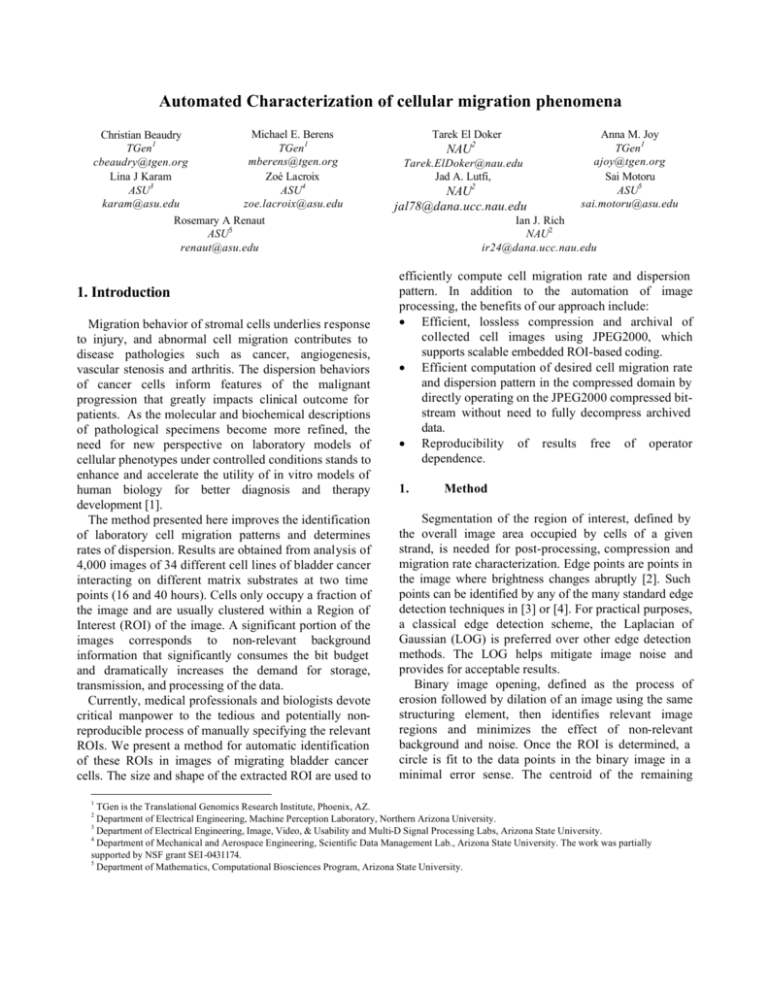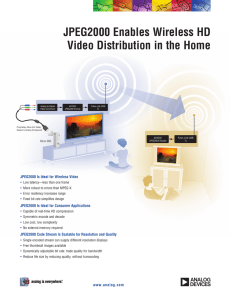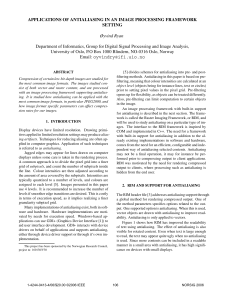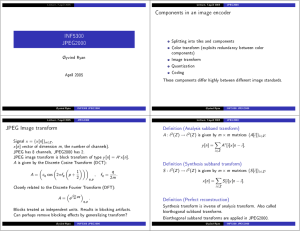79A
advertisement

Automated Characterization of cellular migration phenomena Michael E. Berens Christian Beaudry TGen1 TGen1 mberens@tgen.org cbeaudry@tgen.org Zoé Lacroix Lina J Karam ASU4 ASU3 zoe.lacroix@asu.edu karam@asu.edu Rosemary A Renaut ASU5 renaut@asu.edu 1. Introduction Migration behavior of stromal cells underlies response to injury, and abnormal cell migration contributes to disease pathologies such as cancer, angiogenesis, vascular stenosis and arthritis. The dispersion behaviors of cancer cells inform features of the malignant progression that greatly impacts clinical outcome for patients. As the molecular and biochemical descriptions of pathological specimens become more refined, the need for new perspective on laboratory models of cellular phenotypes under controlled conditions stands to enhance and accelerate the utility of in vitro models of human biology for better diagnosis and therapy development [1]. The method presented here improves the identification of laboratory cell migration patterns and determines rates of dispersion. Results are obtained from analysis of 4,000 images of 34 different cell lines of bladder cancer interacting on different matrix substrates at two time points (16 and 40 hours). Cells only occupy a fraction of the image and are usually clustered within a Region of Interest (ROI) of the image. A significant portion of the images corresponds to non-relevant background information that significantly consumes the bit budget and dramatically increases the demand for storage, transmission, and processing of the data. Currently, medical professionals and biologists devote critical manpower to the tedious and potentially nonreproducible process of manually specifying the relevant ROIs. We present a method for automatic identification of these ROIs in images of migrating bladder cancer cells. The size and shape of the extracted ROI are used to 1 Tarek El Doker NAU2 Tarek.ElDoker@nau.edu Jad A. Lutfi, NAU2 jal78@dana.ucc.nau.edu Anna M. Joy TGen1 ajoy@tgen.org Sai Motoru ASU5 sai.motoru@asu.edu Ian J. Rich NAU2 ir24@dana.ucc.nau.edu efficiently compute cell migration rate and dispersion pattern. In addition to the automation of image processing, the benefits of our approach include: • Efficient, lossless compression and archival of collected cell images using JPEG2000, which supports scalable embedded ROI-based coding. • Efficient computation of desired cell migration rate and dispersion pattern in the compressed domain by directly operating on the JPEG2000 compressed bitstream without need to fully decompress archived data. • Reproducibility of results free of operator dependence. 1. Method Segmentation of the region of interest, defined by the overall image area occupied by cells of a given strand, is needed for post-processing, compression and migration rate characterization. Edge points are points in the image where brightness changes abruptly [2]. Such points can be identified by any of the many standard edge detection techniques in [3] or [4]. For practical purposes, a classical edge detection scheme, the Laplacian of Gaussian (LOG) is preferred over other edge detection methods. The LOG helps mitigate image noise and provides for acceptable results. Binary image opening, defined as the process of erosion followed by dilation of an image using the same structuring element, then identifies relevant image regions and minimizes the effect of non-relevant background and noise. Once the ROI is determined, a circle is fit to the data points in the binary image in a minimal error sense. The centroid of the remaining TGen is the Translational Genomics Research Institute, Phoenix, AZ. Department of Electrical Engineering, Machine Perception Laboratory, Northern Arizona University. 3 Department of Electrical Engineering, Image, Video, & Usability and Multi-D Signal Processing Labs, Arizona State University. 4 Department of Mechanical and Aerospace Engineering, Scientific Data Management Lab., Arizona State University. The work was partially supported by NSF grant SEI-0431174. 5 Department of Mathematics, Computational Biosciences Program, Arizona State University. 2 points in the image defines the circle center. Finally, lossless JPEG2000 compression is performed on the identified region of interest for more efficient storage and processing [5]. image opening step with a predefined threshold, empirically determined from the database. Finally, the determined ROI is fit with a circle and superimposed on the original image. That image region is then compressed (Figure 2). We performed JPEG2000 compression on the image shown left of Figure 1. The ROI was 10% compressed and the rest of the image was compressed 90%. The image was reduced from approximately 1.2 MB to 55kB after compression. Figure 1 - Original image at T-16 (left) and Laplacian of Gaussian edge detection performed on the image (right). 3. Figure 2 - Image opening followed by circle fitting around the region of interest (left) and Circle projected on the original image. Most of the ROI is successfully segmented and compressed (right). 2. Results Figures 1 and 2 illustrate the process of identifying the ROI. The result obtained from the edge analysis step is shown in Figure 1. A Java user interface (see Figure 3) is utilized as a means of managing and archiving the above developed process on hundreds of images. The process is efficient, allowing the user various options, including step-by-step algorithm run and intermediate analysis. Conclusion A new approach for cell migration analysis is presented from an automated image segmentation and ROIcompression standpoint. This is advantageous over the various operator-based, manual approaches in use today. ROI segmentation is accomplished through classical edge detection techniques, followed by image opening to help identify the cell-occupied image region. That region is then compressed for better archival and analysis. Future work includes compressed-domain analysis, to more efficiently identify migration rate and dispersion. Combining our approach with compression techniques such as offered by JPEG2000 will enhance the analysis of the images by providing the ability to vary parameters, work on compressed domain including proximity-based clustering of cells and cell count, etc. Future work will include the design of a database exploiting the features identified by our approach to facilitate image retrieval, comparison, and analysis. References [1] M. E. Berens and C. Beaudry (2003) “Radial Monolayer Cell Migration Assay”, Cancer Cell Culture: Methods and Protocols, Vol. 88, Humana Press, pp. 219-224. [2] D.A. Forsyth and J. Ponce (2003) “Computer Vision, A Modern Approach”, Prentice Hall, pp. 165-181 [3] P.J. Burt (1981) “Fast filter transforms for image processing”, Computer Vision, Graphics, and Image Processing, Vol. 16, pp. 20-51. [4] E. H. Adelson, C. H. Anderson, J. R. Bergen, P. J. Burt and J. M. Ogden (1984) “Pyramid Methods in Image Processing”, RCA Engineer, Vol. 29(6), pp. 33-41. Figure 3 - The Java user interface for archival and analysis of cell migration phenomena. To illustrate the process, edge detection analysis is performed (see Figure 1). The analysis is followed by an [5] D.S. Taubman and M.W. Marcellin (2002) “JPEG2000: Image Compression Fundamentals, Standards, and Practice”, Kluwer Academic Publishers.
![[#SOL-124] [04000] Error while evaluating filter: Compression](http://s3.studylib.net/store/data/007815680_2-dbb11374ae621e6d881d41f399bde2a6-300x300.png)






